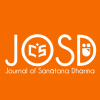What is scripture if it is not understood? What is wisdom if it is not elucidated? The vast corpus of Śāstras and Itihāsas in Sanātana Dharma are not mere texts—they are living, breathing revelations that demand continual interpretation. Brahman is vast, and the Vedas too profound to be comprehended in a single moment or by a single mind. The Bhashyas, Tīkās, and commentaries are not secondary to the sacred texts; they are integral to their unfolding, acting as bridges between the eternal truths and the seeker’s evolving consciousness. In this tradition, interpretation is not an imposition of the interpreter’s views, but a method to uncover deeper layers of meaning, allowing the timeless wisdom of the Vedas and Upanishads to remain relevant and transformative across the ages.
This section of the Journal of Sanātana Dharma invites a deep dive into the art and science of commentarial literature that has shaped our understanding of dharma. From Śankaracharya’s Vedāntic interpretations to Rāmānuja’s devotional exegeses, from Madhva’s dualistic insights to the diverse commentaries on the Mahābhārata and Rāmāyaṇa, the tradition of commentary is one of intellectual ferment and spiritual awakening. How do commentaries illuminate the hidden meanings within ancient texts? What role do they play in adapting dharmic principles to changing times without distorting their essence?
We invite contributions on:
- The philosophy and methodology of Bhashya and Tīkā traditions in Indian commentarial works
- Śankara’s Advaitic interpretation of the Upanishads, Bhagavad Gita, and Brahmasūtras
- Rāmānuja’s Visishtadvaita and the role of Bhakti in interpreting dharma
- Madhva’s dualism and its implications for metaphysical and ethical thought
- The evolution of commentaries on the Mahābhārata and Rāmāyaṇa: From traditional to modern
- The interplay between Shruti (revealed knowledge) and Smṛti (remembered knowledge) in commentarial works
- The role of Purāṇic commentaries in preserving and transmitting cultural and spiritual heritage
- Contemporary commentaries: How modern scholars are revisiting ancient texts
- The impact of colonial and Western interpretations on traditional commentarial literature
- The relevance of commentarial methods in contemporary dharmic discourse and spiritual practice
We welcome research papers, critical essays, and explorations that engage with these commentarial traditions as not just academic exercises but as living dialogues that breathe new life into the timeless wisdom of Sanātana Dharma. The commentators are not mere scholars—they are spiritual guides, leading seekers to deeper understanding, awakening, and liberation.
